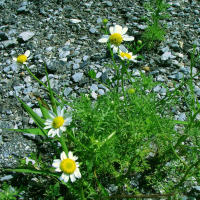Stinking chamomile
Anthemis cotula
Anthemis cotula, commonly known as mayweed, stinking chamomile, or dog fennel, is an annual or biennial herbaceous plant belonging to the Asteraceae family. Native to Europe, it has become widespread in various parts of the world and is known for its distinctive odor. Here is an informative description of Anthemis cotula, including its characteristics, habitat, and ecological aspects:
Description:
-
Growth Form: Mayweed is an erect, bushy herb that typically grows to a height of 30 to 100 centimeters (12 to 40 inches).
-
Leaves: The leaves are finely divided, feathery, and alternate along the stem. They have a pinnate or bipinnate appearance.
-
Flowers: The flowering heads are daisy-like, with white rays surrounding a yellow central disc. The heads are solitary and borne on long stems.
-
Odor: One of the distinctive features of mayweed is its strong, unpleasant odor when crushed or bruised.
-
Stems: The stems are often reddish-brown in color and are typically highly branched.
Habitat:
Mayweed is commonly found in disturbed areas, such as fields, gardens, roadsides, and waste places. It can tolerate a variety of soil types and is often associated with human activities that disturb the soil.
Identification:
Identifying Anthemis cotula involves recognizing its key features:
-
Feathery Leaves: The finely divided, feathery leaves are alternate along the stem.
-
Daisy-Like Flowers: The flowers have white rays surrounding a yellow central disc, resembling daisies.
-
Strong Odor: Crushing the leaves or stems releases a strong, unpleasant odor.
-
Branched Stems: The stems are often highly branched.
Ecological Significance:
-
Invasive Nature: Mayweed can be invasive in certain areas, particularly in disturbed habitats. It competes with native vegetation and may impact ecosystem dynamics.
-
Allelopathy: The plant may release chemicals into the soil that inhibit the growth of other plant species, a phenomenon known as allelopathy.
Management:
Management strategies for controlling mayweed may include:
-
Cultural Control: Maintaining healthy stands of desirable vegetation can help suppress the growth of mayweed.
-
Herbicides: Selective herbicides may be used for targeted control, particularly in agricultural or disturbed areas.
-
Mowing: Regular mowing can prevent the plant from producing seeds and reduce its spread.
-
Prevention: Implementing preventive measures, such as minimizing soil disturbance and monitoring for early infestations, can be effective.













